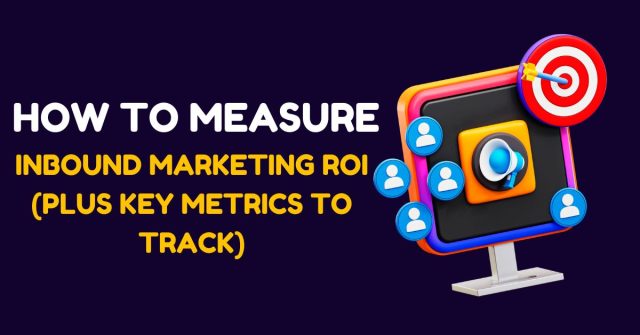Measuring inbound marketing ROI can feel like trying to solve a puzzle with missing pieces. Unlike traditional advertising where you can directly trace a billboard view to a purchase, inbound marketing creates a web of touchpoints that influence buyers over weeks or months.
The challenge becomes even more complex when you consider that 95% of B2B buyers research solutions online before making contact with sales teams. Your blog post from three months ago might be the reason someone finally converts today. So how do you connect those dots and prove the value of your inbound marketing efforts?
What Is Inbound Marketing ROI?

Inbound marketing ROI measures the revenue generated from your inbound marketing activities compared to what you invested in them. The basic formula looks like this:
ROI = (Revenue Generated – Marketing Investment) / Marketing Investment × 100
However, this straightforward calculation becomes more nuanced when you factor in the extended buyer’s journey that characterizes inbound marketing. Unlike paid advertising, where attribution is often immediate, inbound marketing typically involves multiple touchpoints across several months.
For example, a prospect might discover your company through a blog post, download an ebook, attend a webinar, and then request a demo before making a purchase. Each touchpoint contributes to the final conversion, making it essential to track the entire customer journey rather than just the last interaction.
Essential Metrics for Measuring Inbound Marketing ROI
Revenue Metrics
Customer Lifetime Value (CLV) represents the total revenue a customer will generate over their relationship with your company. For inbound marketing measurement, CLV helps you understand the long-term impact of acquiring customers through organic channels.
Customer Acquisition Cost (CAC) calculates how much you spend to acquire each new customer through inbound marketing. This includes content creation costs, marketing automation tools, staff salaries, and any other expenses directly related to your inbound efforts.
Monthly Recurring Revenue (MRR) tracks predictable revenue streams, particularly important for subscription-based businesses using inbound marketing to drive growth.
Traffic and Engagement Metrics
Organic traffic growth measures how effectively your content attracts visitors through search engines and other unpaid channels. Quality organic traffic often converts better than paid traffic because visitors arrive with genuine interest in your solutions.
Conversion rates at each stage of your funnel reveal where your inbound strategy excels and where it needs improvement. Track conversions from visitor to lead, lead to opportunity, and opportunity to customer.
Time on site and pages per session indicate content quality and visitor engagement. Higher engagement typically correlates with better conversion rates and stronger ROI.
Lead Generation Metrics
Marketing Qualified Leads (MQLs) represent prospects who have engaged with your content enough to warrant sales attention. Track both MQL volume and quality to ensure your inbound efforts attract the right audience.
Lead scoring helps prioritize prospects based on their behavior and characteristics. Higher-scoring leads typically convert faster and generate more revenue.
Cost per lead breaks down your inbound marketing investment by the number of leads generated, helping you optimize budget allocation across different channels and tactics.
Step-by-Step Guide to Calculate Inbound Marketing ROI
Step 1: Define Your Attribution Model
Choose how you’ll credit inbound marketing touchpoints for conversions. Common models include:
First-touch attribution gives all credit to the first interaction, ideal for measuring top-of-funnel content effectiveness.
Last-touch attribution credits the final touchpoint before conversion, useful for identifying what closes deals.
Multi-touch attribution distributes credit across all touchpoints, providing the most comprehensive view of your inbound marketing impact.
Most mature inbound marketing programs use multi-touch attribution because it better reflects the complex buyer’s journey.
Step 2: Track Your Marketing Investment
Calculate your total inbound marketing spend, including:
- Content creation costs (writing, design, video production)
- Marketing automation and CRM software
- SEO tools and analytics platforms
- Staff salaries for team members focused on inbound marketing
- Paid promotion of organic content
- Website development and optimization
Step 3: Measure Revenue Attribution
Connect revenue back to your inbound marketing efforts by tracking:
- Deals influenced by inbound touchpoints
- Pipeline value from inbound-generated leads
- Customer lifetime value for inbound-acquired customers
- Upsell and cross-sell revenue from existing inbound customers
Step 4: Apply the ROI Formula
Once you have your revenue and investment figures, apply the standard ROI calculation:
ROI = (Inbound Marketing Revenue – Inbound Marketing Investment) / Inbound Marketing Investment × 100
For example, if you invested $50,000 in inbound marketing and generated $200,000 in attributed revenue, your ROI would be 300%.
Tools and Platforms for Measuring Inbound Marketing ROI
Google Analytics 4
GA4 provides essential insights into traffic sources, user behavior, and conversion paths. Set up goals and events to track key actions like form submissions, content downloads, and demo requests. The Attribution reports help you understand how different touchpoints contribute to conversions.
HubSpot
HubSpot’s marketing analytics dashboard tracks the entire customer journey from first visit to closed deal. The attribution reporting shows which content and channels drive the most revenue, while the ROI calculator automatically measures campaign performance.
Salesforce
Salesforce CRM integration allows you to connect marketing activities with closed deals. Use campaign influence reports to see how marketing touchpoints affect pipeline and revenue generation.
Marketing Automation Platforms
Tools like Marketo, Pardot, or ActiveCampaign track lead scoring, email engagement, and nurture sequence performance. These platforms help you understand which automated touchpoints contribute most to conversions.
Call Tracking Software
Solutions like CallRail or DialogTech connect phone calls back to specific marketing campaigns, crucial for B2B companies where phone conversations often finalize deals.
Common Challenges in Measuring Inbound Marketing ROI
Long Sales Cycles
B2B sales cycles often span 6-18 months, making it difficult to connect early-stage content with eventual purchases. Address this by tracking leading indicators like engagement metrics and pipeline influence rather than just closed deals.
Multiple Touchpoints
Modern buyers interact with dozens of touchpoints before converting. Use marketing attribution software to map the complete customer journey and assign appropriate credit to each interaction.
Data Silos
Marketing and sales teams often use different systems that don’t communicate effectively. Implement integrated platforms or regular data synchronization to maintain accurate attribution.
Offline Conversions
Not all conversions happen digitally. Phone calls, in-person meetings, and referrals can stem from inbound marketing efforts but may not be properly tracked. Implement call tracking and train sales teams to ask about content consumption during discovery calls.
Advanced ROI Measurement Strategies
Cohort Analysis
Group customers by acquisition month and track their long-term value. This reveals whether your inbound marketing attracts customers who stick around and grow their spending over time.
Incrementality Testing
Run controlled experiments where you pause specific inbound activities for certain audience segments. Compare conversion rates between test and control groups to isolate the true impact of your inbound efforts.
Marketing Mix Modeling
Statistical analysis that measures how different marketing channels work together to drive results. This approach helps you understand how inbound marketing amplifies or is amplified by other marketing activities.
Customer Journey Mapping
Document every touchpoint in your customer’s path to purchase, then assign value to each interaction based on its influence on the final decision. This creates a more nuanced understanding of content ROI.
Optimizing Your Inbound Marketing ROI

Content Performance Analysis
Regularly audit your content to identify which pieces drive the most qualified traffic and conversions. Double down on high-performing topics and formats while eliminating or updating underperforming content.
Lead Scoring Refinement
Continuously optimize your lead scoring model based on which behaviors and characteristics predict actual purchases. This helps sales teams focus on the highest-value prospects.
Conversion Rate Optimization
Test landing pages, calls-to-action, and form fields to improve conversion rates at each funnel stage. Small improvements compound over time to significantly boost ROI.
Channel Performance Review
Analyze which inbound channels (organic search, social media, email, referrals) generate the highest-quality leads and focus resources accordingly.
Building Your Inbound Marketing ROI Framework
Start by establishing baseline measurements for your current inbound marketing performance. Choose 5-7 key metrics that align with your business goals and track them consistently over time.
Set up proper attribution tracking early, even if your current tools are basic. You can always upgrade to more sophisticated platforms as your program matures and budget allows.
Create monthly reports that connect marketing activities to business outcomes. Share these with leadership to demonstrate value and secure continued investment in your inbound strategy.
Remember that inbound marketing ROI measurement is an ongoing process, not a one-time calculation. The most successful programs continuously refine their measurement approach as they learn what drives real business results.




